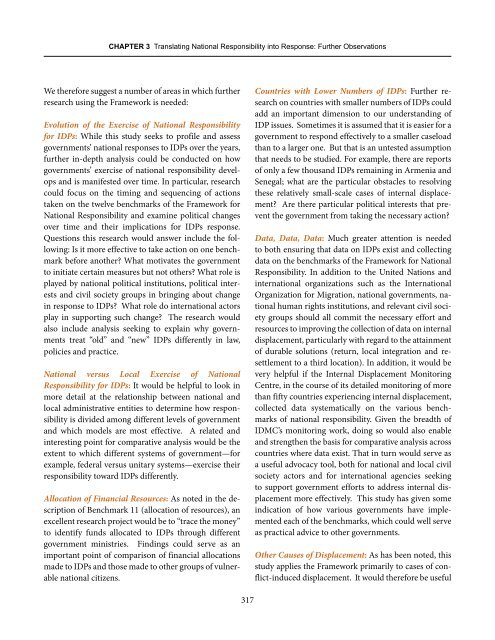From Responsibility to Response: Assessing National - Brookings
From Responsibility to Response: Assessing National - Brookings
From Responsibility to Response: Assessing National - Brookings
You also want an ePaper? Increase the reach of your titles
YUMPU automatically turns print PDFs into web optimized ePapers that Google loves.
CHAPTER 3 Translating <strong>National</strong> <strong>Responsibility</strong> in<strong>to</strong> <strong>Response</strong>: Further Observations<br />
We therefore suggest a number of areas in which further<br />
research using the Framework is needed:<br />
Evolution of the Exercise of <strong>National</strong> <strong>Responsibility</strong><br />
for IDPs: While this study seeks <strong>to</strong> profile and assess<br />
governments’ national responses <strong>to</strong> IDPs over the years,<br />
further in-depth analysis could be conducted on how<br />
governments’ exercise of national responsibility develops<br />
and is manifested over time. In particular, research<br />
could focus on the timing and sequencing of actions<br />
taken on the twelve benchmarks of the Framework for<br />
<strong>National</strong> <strong>Responsibility</strong> and examine political changes<br />
over time and their implications for IDPs response.<br />
Questions this research would answer include the following:<br />
Is it more effective <strong>to</strong> take action on one benchmark<br />
before another? What motivates the government<br />
<strong>to</strong> initiate certain measures but not others? What role is<br />
played by national political institutions, political interests<br />
and civil society groups in bringing about change<br />
in response <strong>to</strong> IDPs? What role do international ac<strong>to</strong>rs<br />
play in supporting such change? The research would<br />
also include analysis seeking <strong>to</strong> explain why governments<br />
treat “old” and “new” IDPs differently in law,<br />
policies and practice.<br />
<strong>National</strong> versus Local Exercise of <strong>National</strong><br />
<strong>Responsibility</strong> for IDPs: It would be helpful <strong>to</strong> look in<br />
more detail at the relationship between national and<br />
local administrative entities <strong>to</strong> determine how responsibility<br />
is divided among different levels of government<br />
and which models are most effective. A related and<br />
interesting point for comparative analysis would be the<br />
extent <strong>to</strong> which different systems of government—for<br />
example, federal versus unitary systems—exercise their<br />
responsibility <strong>to</strong>ward IDPs differently.<br />
Allocation of Financial Resources: As noted in the description<br />
of Benchmark 11 (allocation of resources), an<br />
excellent research project would be <strong>to</strong> “trace the money”<br />
<strong>to</strong> identify funds allocated <strong>to</strong> IDPs through different<br />
government ministries. Findings could serve as an<br />
important point of comparison of financial allocations<br />
made <strong>to</strong> IDPs and those made <strong>to</strong> other groups of vulnerable<br />
national citizens.<br />
317<br />
Countries with Lower Numbers of IDPs: Further research<br />
on countries with smaller numbers of IDPs could<br />
add an important dimension <strong>to</strong> our understanding of<br />
IDP issues. Sometimes it is assumed that it is easier for a<br />
government <strong>to</strong> respond effectively <strong>to</strong> a smaller caseload<br />
than <strong>to</strong> a larger one. But that is an untested assumption<br />
that needs <strong>to</strong> be studied. For example, there are reports<br />
of only a few thousand IDPs remaining in Armenia and<br />
Senegal; what are the particular obstacles <strong>to</strong> resolving<br />
these relatively small-scale cases of internal displacement?<br />
Are there particular political interests that prevent<br />
the government from taking the necessary action?<br />
Data, Data, Data: Much greater attention is needed<br />
<strong>to</strong> both ensuring that data on IDPs exist and collecting<br />
data on the benchmarks of the Framework for <strong>National</strong><br />
<strong>Responsibility</strong>. In addition <strong>to</strong> the United Nations and<br />
international organizations such as the International<br />
Organization for Migration, national governments, national<br />
human rights institutions, and relevant civil society<br />
groups should all commit the necessary effort and<br />
resources <strong>to</strong> improving the collection of data on internal<br />
displacement, particularly with regard <strong>to</strong> the attainment<br />
of durable solutions (return, local integration and resettlement<br />
<strong>to</strong> a third location). In addition, it would be<br />
very helpful if the Internal Displacement Moni<strong>to</strong>ring<br />
Centre, in the course of its detailed moni<strong>to</strong>ring of more<br />
than fifty countries experiencing internal displacement,<br />
collected data systematically on the various benchmarks<br />
of national responsibility. Given the breadth of<br />
IDMC’s moni<strong>to</strong>ring work, doing so would also enable<br />
and strengthen the basis for comparative analysis across<br />
countries where data exist. That in turn would serve as<br />
a useful advocacy <strong>to</strong>ol, both for national and local civil<br />
society ac<strong>to</strong>rs and for international agencies seeking<br />
<strong>to</strong> support government efforts <strong>to</strong> address internal displacement<br />
more effectively. This study has given some<br />
indication of how various governments have implemented<br />
each of the benchmarks, which could well serve<br />
as practical advice <strong>to</strong> other governments.<br />
Other Causes of Displacement: As has been noted, this<br />
study applies the Framework primarily <strong>to</strong> cases of conflict-induced<br />
displacement. It would therefore be useful

















